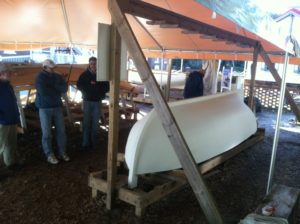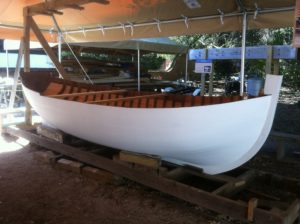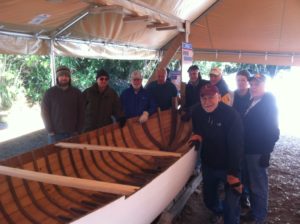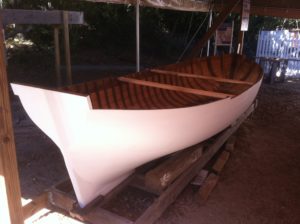Thursday, February 19th, was a bright and beautiful sunny morning. It was also the coldest we have had in St. Augustine this winter with one Lighthouse neighbor observing 31⁰ F on his thermometer during the early morning hours. It seems a little much however, to be complaining about the weather in Florida while the rest of the country is blown and battered by record low temperatures. Regardless, the big news on this particular morning was not the weather. The big news today was the flipping of the yawl boat that has been under construction since 2009.
During the building process the boat has been flipped on a number of different occasions. This one has particular importance as a mile stone because the yawl has been completely planked, had its planking seams caulked with cotton, and had the same seams primed and then paid with a seam compound to keep the caulking in place. And last but not least, two coats of primer paint have been lovingly applied to the entire exterior of the hull.
This construction has been the biggest challenge undertaken by the heritage wooden boatworks at the Lighthouse. The yawl boat is based on a lines drawing dated 1760 discovered in British archives by Howard Chapelle who made a draft of the lines along with many others from those archives which later ended up at the Smithsonian where Chapelle was curator of transportation. His draft of the 1760 yawl boat lines were later found in the Smithsonian Institution’s collections by the author during his internship at the National Museum of American History in 1990. He never imagined that those lines would be brought to life years later through the dedication of clever and hard working volunteers.
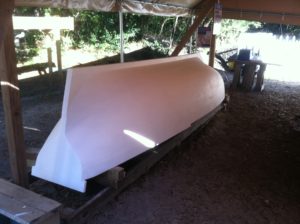 The Yawl Boat On Its Strong Back Before Flipping
The Yawl Boat On Its Strong Back Before Flipping
We had ten people, five to either side of the boat, when we flipped it. We carefully lifted the boat and then rolled it onto two 2x4s covered with sections of old canvas fire hose for padding until the yawl came to rest on her keel on a pair of wooden chalks on the ground. It was the first time we got to see the inside of the fully planked hull. Then using rope, a section of canvas fire hose and the two cross-spalls (temporary horizontal timbers stabilizing the sides of the boat so the boat wont flex and crack) as hand holds we lifted the boat and moved it back onto its strong back, the wooden structure upon which the boat is built.
What a sight it makes sitting on its keel, pretty as you please. The hull has the beautiful lines of most eighteenth century water craft when wooden boat building was a highly developed art form that mixed beauty with durable functionality. This yawl boat however is special for a number of reasons. Firstly, it represents the oldest form of traditional wooden boatbuilding undertaken by the LAMP Boatworks to date. It is also historically appropriate for St. Augustine where such craft were commonly found here during the British Period and indeed representative of the many craft that no doubt played a role in the successful rescue of the passengers and crew of the vessel wrecked on the St. Augustine Bar that is today under archaeological investigation by LAMP and known as the Storm Wreck.
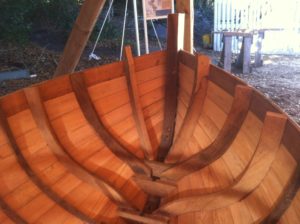 The Framing, Or Ribs, In The Bow
The Framing, Or Ribs, In The Bow
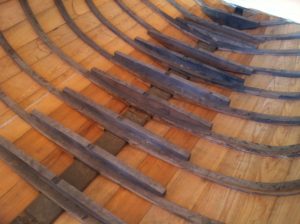 Framing In The Center Of The Yawl Boat
Framing In The Center Of The Yawl Boat
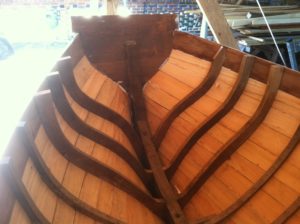 Photograph Showing The Stern Including The Stern Knee And Transom
Photograph Showing The Stern Including The Stern Knee And Transom
But perhaps most of all, this yawl boat is special because it is also a product of the local, St. Augustine environment. This boat is planked in local cypress wood rather than traditional English oak. During the construction process we could not get steamed cypress to take the necessary bends and twists in the bow that the lines drawing called for. After breaking more planks then I care to number, we realized that cypress just can’t bend like English oak. Consequently, we reduced the bluffness of the bow in order to accommodate the building material that we, as well as St. Augustine based eighteenth century British boat carpenters, used in building this boat and its kind during the British Period. It is a perfect example of environment effecting design. This yawl boat there for is not just an ordinary British yawl boat, it is a St. Augustine yawl boat- sharper in the bow and very likely faster moving through the water. I can’t wait to find out!
Such Graceful Lines!
Dr. Sam Turner joined the St. Augustine Lighthouse & Museum in 2006. Dr. Turner earned his master’s in nautical archaeology at Texas A&M University and received his Ph.D. in Spanish and Spanish American studies from King’s College of the University of London.


